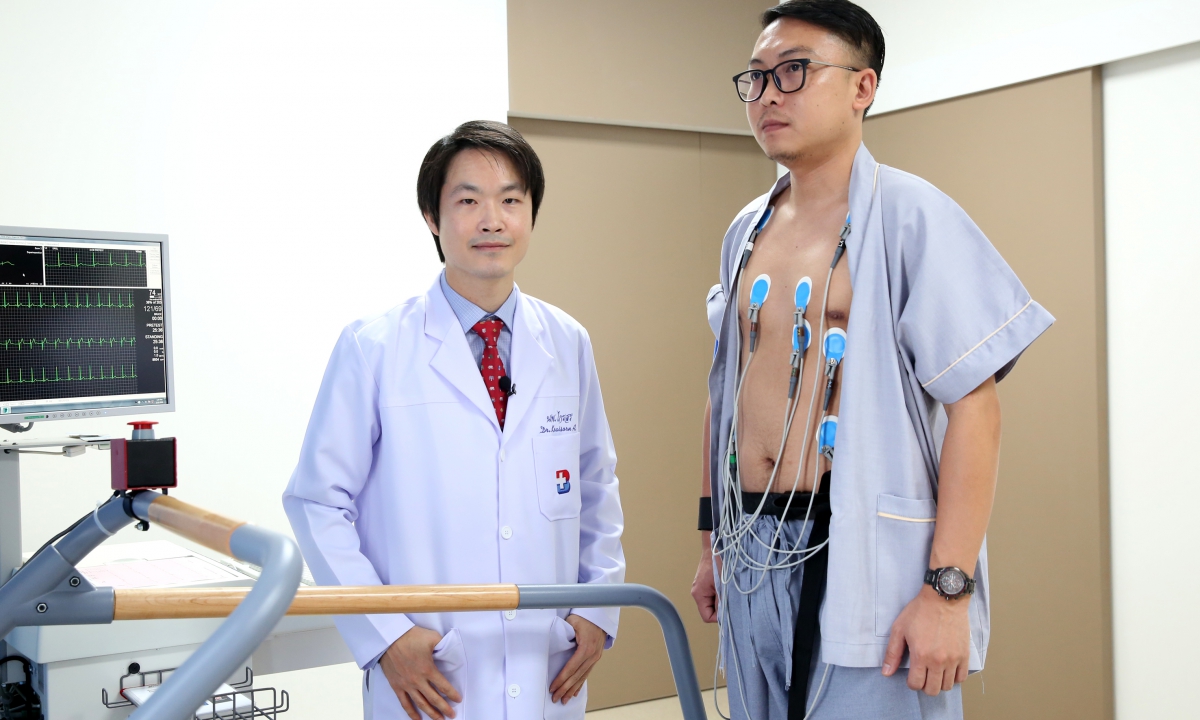
การตรวจพิเศษทางหัวใจมีประโยชน์อย่างมากทั้งในการวินิจฉัยและประเมินความรุนแรงของโรคหัวใจ หลังจากที่แพทย์ได้ทำการซักประวัติ ตรวจร่างกาย รวมถึงส่งตรวจเบื้องต้น เช่น การตรวจเลือด คลื่นไฟฟ้าหัวใจ หรือเอกซเรย์ทรวงอก
การตรวจพิเศษที่สำคัญและถูกนำมาใช้อยู่เป็นประจำประกอบด้วย การตรวจเดินสายพาน อัลตราซาวด์หัวใจ เอกซเรย์คอมพิวเตอร์หลอดเลือดหัวใจ และการฉีดสีหลอดเลือดหัวใจ
การเดินสายพาน (Exercise stress test)
การตรวจเดินสายพาน เป็นการตรวจเพื่อวินิจฉัยโรคหลอดเลือดหัวใจ ในรายที่มีอาการเจ็บแน่นหน้าอกหรือหอบเหนื่อยง่ายเวลาออกแรง หรือในรายที่ยังไม่มีอาการแต่มีความเสี่ยงในการเกิดโรคหลอดเลือดหัวใจนอกจากนั้นยังสามารถทดสอบสมรรถภาพการทำงานของหัวใจ ปอดและกล้ามเนื้อ จึงเหมาะในผู้ที่ต้องการตรวจสมรรถภาพการทำงานของหัวใจก่อนการผ่าตัด หรือก่อนการแข่งขันกีฬาหรือการออกกำลังกายอย่างหนัก
หลักการตรวจคือการเดินหรือวิ่งเพื่อกระตุ้นให้หัวใจทำงานหนักขึ้น จากนั้นสังเกตอาการหรือความผิดปกติที่จะเกิดขึ้นที่คลื่นไฟฟ้าหัวใจ ในขณะทำการตรวจผู้รับการตรวจจะต้องเดินหรือวิ่งบนสายพานเพื่อกระตุ้นให้หัวใจเต้นเร็วขึ้นจนถึงเป้าหมายที่ตั้งไว้ ซึ่งมักจะใช้เวลาในการเดินโดยประมาณ 6-12 นาที โดยมีสายตรวจคลื่นไฟฟ้าหัวใจแป๊ะไว้บริเวณหน้าอกเพื่อคอยติดตามการเปลี่ยนแปลงของคลื่นไฟฟ้าหัวใจ การแปลผลจะพิจารณาจากอาการ ว่ามีอาการเจ็บแน่นหน้าอกหรือไม่ ร่วมกับการวิเคราะห์การเปลี่ยนแปลงของคลื่นไฟฟ้าหัวใจ ซึ่งจะเห็นได้ว่าเป็นการตรวจวินิจฉัยโรคหลอดเลือดหัวใจทางอ้อม เนื่องจากเราไม่ได้มองเห็นหลอดเลือดหัวใจโดยตรงว่าตีบหรือไม่ การตรวจชนิดนี้จึงมีความแม่นยำในการตรวจประมาณ70-80% แต่เนื่องจากเป็นวิธีที่ง่ายจึงเหมาะที่จะเป็นเครื่องมือในการตรวจคัดกรองเบื้องต้น ดังนั้นในรายที่ผลการตรวจไม่ชัดเจน หรือ คาดว่าไม่สามารถตรวจเดินสายพานได้เนื่องจากข้อจำกัดทางด้านร่างกาย แพทย์จะแนะนำให้ตรวจพิเศษด้วยวิธีการอื่นๆ
การอัลตราซาวด์หัวใจ (Echocardiogram)
การตรวจอัลตราซาวด์หัวใจอาศัยคลื่นอัลตราซาวด์ในการสร้างภาพ ทำให้เราได้ข้อมูลทั้งในแง่ของรูปร่างลักษณะ และการทำงานของหัวใจ ร่วมไปถึงสามารถตรวจวัดความดันในส่วนต่างๆของหัวใจและหลอดเลือดได้ จึงเป็นเครื่องมือที่มีประโยชน์มากที่ใช้ในการวินิจฉัยโรคหัวใจแทบจะทุกชนิด ไม่ว่าจะเป็นโรคของลิ้นหัวใจ กล้ามเนื้อหัวใจ เยื่อหุ้มหัวใจ หรือแม้กระทั่งโรคหลอดเลือดเลือดหัวใจตีบ การตรวจอัลตราซาวด์หัวใจมีบทบาททั้งการวินิจฉัยและประเมินความรุนแรงของโรค การตรวจชนิดนี้จึงเหมาะเป็นการตรวจพิเศษในรายที่มีอาการบ่งชี้ว่าจะมีโรคหัวใจ ไม่ว่าจะเป็นอาการเจ็บแน่นหน้าอก หายใจหอบเหนื่อย ใจสั้น บวม หรือหน้ามืดเป็นลม หรือแม้แต่ในผู้ป่วยโรคความดันโลหิตสูงที่ยังไม่มีอาการผิดปกติ การตรวจชนิดนี้ก็ช่วยประเมินภาวะกล้ามเนื้อหัวใจหนาตัวจากความดันโลหิตสูงได้เป็นอย่างดี
ในแง่ของการตรวจเพื่อวินิจฉัยโรคหลอดเลือดหัวใจตีบ การตรวจวิธีนี้จะไม่เห็นหลอดเลือดหัวใจโดยตรง แต่จะเป็นการวินิจฉัยทางอ้อมโดยพิจารณาจากการทำงานของกล้ามเนื้อหัวใจ ซึ่งในผู้ป่วยที่มีโรคหลอดเลือดหัวใจและกล้ามเนื้อหัวใจขาดเลือดอย่างรุนแรง หรือในรายที่เคยมีกล้ามเนื้อหัวใจตายมาก่อน จะตรวจพบการทำงานของกล้ามเนื้อหัวใจที่ผิดปกติ เช่น กล้ามเนื้อหัวใจบีบตัวอ่อนแรงลง ผนังกล้ามเนื้อหัวใจบางลง หรือขนาดของหัวใจโตขึ้น การตรวจอัลตราซาวด์หัวใจจึงมีประโยชน์อย่างมากทั้งในการวินิจฉัยและการประเมินความรุนแรงของโรคขณะทำการตรวจผู้รับการตรวจจะอยู่ในท่านอนตะแคงซ้าย และเปิดหน้าอกด้านช้ายเพื่อใช้เป็นบริเวณในการวางหัวตรวจอัลตราซาวด์ การตรวจใช้เวลาไม่นานและสามารถทราบผลการตรวจทันที
เอกซเรย์คอมพิวเตอร์ (CT scan)
การตรวจเอกซเรย์คอมพิวเตอร์อาศัยรังสีเอกซเรย์ในการสร้างภาพ ทำให้เห็นโครงสร้างของหัวใจทั้งหมดและยังสามารถประเมินแคลเซียมในหลอดเลือดหัวใจ (CAC) ซึ่งช่วยทำนายโอกาสเกิดโรคหลอดเลือดหัวใจ หากทำการฉีดสารทึบรังสีเข้าทางหลอดเลือดขณะตรวจ ซึ่งเรียกว่าการตรวจเอกซเรย์คอมพิวเตอร์หลอดเลือดหัวใจ (CT coronary angiogram) จะทำให้มองเห็นหลอดเลือดหัวใจได้ สามารถประเมินได้ว่าหลอดเลือดหัวใจตีบหรือไม่ จึงมีประโยชน์อย่างมากในการวินิจฉัยโรคหลอดเลือดหัวใจ การตรวจหลอดเลือดหัวใจด้วยเอกซเรย์คอมพิวเตอร์ มีความแม่นยำสูงมาก จึงเหมาะที่จะใช้เป็นเครื่องมือในการตรวจหาโรคหลอดเลือดหัวใจในรายที่มีอาการหรือมีความเสี่ยงในการเกิดโรค ที่ไม่สามารถเดินสายพาน หรือ ตรวจด้วยวิธีการอื่นแล้วยังได้ผลไม่ชัดเจน
การฉีดสีหลอดเลือดหัวใจ
การตรวจชนิดนี้ทำให้เรามองเห็นหลอดเลือดหัวใจได้โดยการฉีดสารทึบรังสีเข้าสู่หลอดเลือดหัวใจโดยตรงผ่านทางสายสวน แล้วอาศัยรังสีเอกซเรย์ในการสร้างภาพ จึงถือเป็นการตรวจมีความแม่นยำที่สุดและเป็น gold standard คือเป็นการตรวจมาตรฐานที่ให้ผลลัพธ์เป็นคำตอบสุดท้ายในการวินิจฉัยโรคหลอดเลือดหัวใจ นอกจากนั้น การตรวจฉีดสีหลอดเลือดหัวใจ ยังเป็นส่วนหนึ่งในขั้นตอนการรักษาโรคหลอดเลือดหัวใจด้วยการขยายด้วยบอลลูนและการใส่ขดลวดค้ำยันผนังหลอดเลือด นับได้ว่าเป็นเครื่องมือที่มีประโยชน์ทั้งในการวินิจฉัยและการรักษาในเวลาเดียวกัน
การตรวจชนิดนี้มีข้อบ่งชี้ในผู้ที่ประเมินจากประวัติและอาการแล้วว่ามีโอกาสสูงมากที่จะมีโรคหลอดเลือดหัวใจ หรือผู้ที่ผ่านการตรวจพิเศษด้วยวิธีการอื่นแล้วให้ผลผิดปกติ และจะทำการตรวจเป็นกรณีเร่งด่วนหากผู้ป่วยมีภาวะกล้ามเนื้อหัวใจตายเฉียบพลัน เนื่องจากเป็นหัตถการที่ทำผ่านทางสายสวนจึงมีเพียงบาดแผลขนาดเล็กจากการใส่สายสวนบริเวณขาหนีบหรือข้อมือ จึงสามารถทำหัตถการภายใต้การฉีดยาชาเฉพาะที่ และมีระยะเวลาในการพักฟื้นสั้น โดยเฉพาะผู้ที่ทำผ่านทางหลอดเลือดแดงบริเวณข้อมือ จะสามารถลุกนั่งหรือเดินได้ไม่นานหลังทำหัตถการ